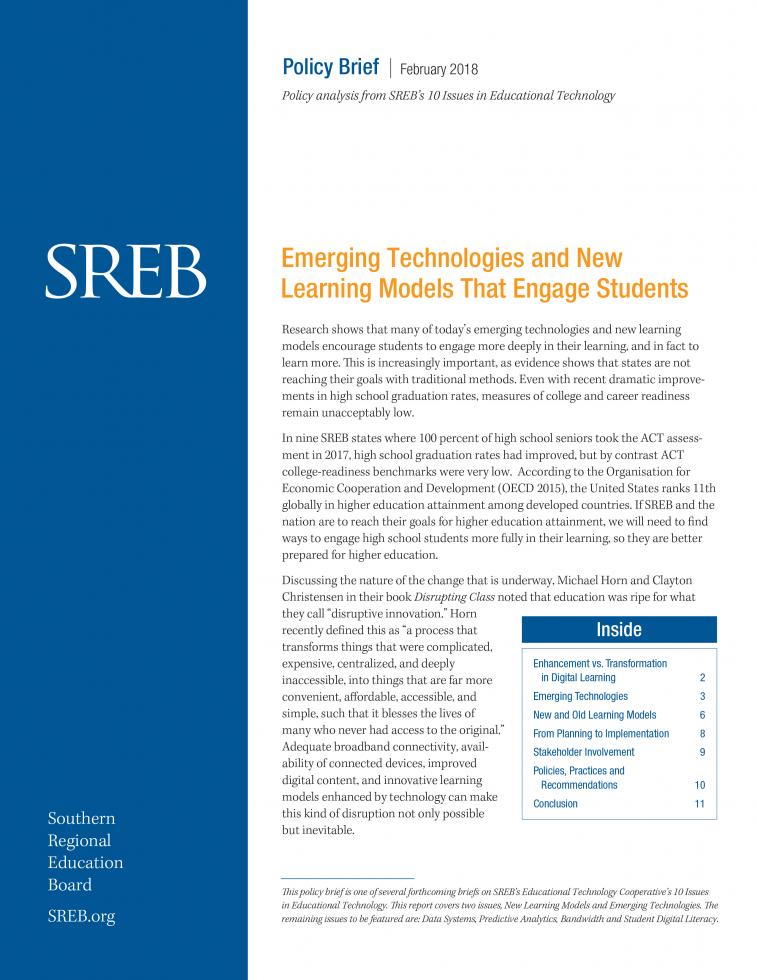New Learning Models
New Learning Models
Provide for more use of technology to create personalized, competency-based learning environments and delivery methods that allow students to demonstrate mastery of content at their own pace.
More schools and colleges are seeking new and innovative learning models to provide students with greater engagement, flexibility and control of their learning experience. Some have linked new technology applications to older learning models to create breakthrough innovations:
In competency-based education, students move through a course at their own pace as they master pre-determined competencies. Course length is not defined by a calendar and is not measured by Carnegie units. Technology tools provide timely assessment to students on where they stand on competencies and what they need to complete.
Adaptive learning is sequenced by technology tools. These tools recognize when students have or have not met competencies and present learning materials accordingly — stressing unlearned concepts as needed and moving ahead as appropriate. It incorporates mastery learning because the student does not move forward until s/he has mastered the concepts, leaving no gaps in knowledge.
Personalized learning is a student-centric model that provides more student choice for evidence of learning, often incorporating adaptive, mastery, and competency-based learning.
What is the issue and why is it important?
While high school graduation rates have improved nationwide, national assessments of college readiness show that far too many graduates are not ready for college and careers. Education leaders have focused on new learning models for high schools that build competencies and skill sets for college and career readiness by focusing on deeper, more engaged learning.
Teaching to a classroom of students and focusing on the elusive “average” student is no longer effective. With modern teaching tools — computer diagnostic exams, formative assessments, and adaptive content to meet individual students’ needs — teachers can foster more individualized approaches to teaching that can result in deeper learning and better student engagement. Engaged students are more likely to persist in educational tasks until they reach their goal.
One goal for new learning models is to help students who have some college complete their degrees.
College faculty are serious about exploring new models. Examples include prior learning assessment, self-paced learning, module-based delivery, flipped classrooms, game-based learning, use of artificial intelligence for tutoring, virtual reality, augmented reality and mixed reality. Formats designed to allow students more control over pacing, learning style and how they express their learning could provide them with affordable options that honor their prior learning as well as adapt to their specific needs. These formats focus on outcomes rather than time spent in the classroom.
Barriers to implementation, such as policies, regulations and accreditation guidelines, need to be matched to the promise of these innovations. As with all academic programs, these new learning models must prove themselves with evidence-based research and be developed with appropriate rigor and quality. They will likely undergo continuous cycles of improvement as they mature to meet the high educational demands of the future, as well as student and employer expectations. But waiting for significant studies to determine the effectiveness of new models should not hinder institutions from experimenting, so long as they monitor effectiveness and report results.
What if SREB states do not make adequate progress on this issue?
The goal for new learning models is to increase retention among traditional students and facilitate college completion for the non-traditional students who have some college but no degree. Without new learning models, a college degree will remain unattainable for the 29 million Americans qualifed to enter college, but for whom family, work and socio-economic circumstances preclude completion of a traditional program.
For K-12 education, these models can be the difference between a high school dropout and a student well-prepared for college or career.




